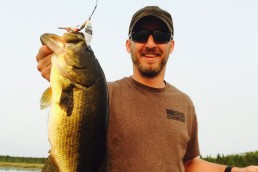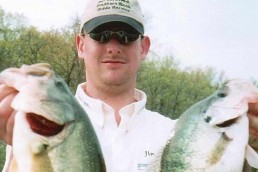Fishing Small Lakes for Big Fish and Big Fun
SHARE THIS POST
Small lakes are productive fisheries, and some rank up there as great ones. They usually aren’t on “favorite” lists as destinations, but that doesn’t mean they should be overlooked. Fishing pressure on these might only be the grandkids fishing off the dock or a one-cabin owner casting a spinnerbait. Some of these do receive considerable fishing pressure when bluegills are spawning and the big fish become accessible. Or, when an angler needs that early-season rust knocked loose by the tug of a largemouth. Still, many target traditional, larger lakes and pass over the smaller waters.
Small lakes can become weed-choked and don’t appear hospitable to anglers in summer. Launch ramps on many of these lakes are sand, or even worse. Sometimes, anglers slip a 12- or 14-foot boat in and even have to walk it out to deeper water before jumping aboard. A boat that cannot be lifted or slid by two men is too big to get into these waters and then canoes or kayaks are the option.
A definition of “my” small lake could be from a few acres to 50, 60, or a bit more. Another definition deals with fish: panfish. Then add bass to most, with pike to quite a few. Walleyes exist in only a couple unless property owners enhance their populations. If streams run into nearby walleye lakes, the walleyes may also be present. Crappies’ year-class and size fluctuate significantly, and smallmouth bass aren’t a factor as a rule.
A largemouth angler could pick up a spinnerbait and toss it at every likely looking spot while moving around the shoreline. At docks and shore stations he could flip a worm, and after a round or two, might comb the weedline depths with a plastic worm. If the lake features a hump topping off at 10 to 25 feet, the same set of presentations combined with a crankbait could be utilized. In the matted weed slop, a weedless “frog” lure snaked across the surface would be in order.
But that’s making life too easy. And small lakes don’t always fish like small lakes and require planning and research. Before heading to a new spot, pull up a lake map on a computer. Print a map and look for main-lake points, islands, sharp drop-offs, bottom composition, etc. The written description from a guide or the fisheries department may deal with visibility, weeds, fish test-netting results, stocking data, and more.
A good small-lake sleuth listens. When someone mentions that Uncle Joe caught some 10-inch sunnies on “Lake X,” file this tidbit of news away. If you happen to see a photo of little Tommy with a 5-pound largemouth bass, take note. Big fish run in cycles, and small lakes with minimal fishing pressure don’t give up their secrets as quickly as a hot bite on the Mille Lacs flats or the Lake Winnebago “mud.”
A typical exploration would start out for me by driving slowly to the access point when going around the lake and stopping to visit any local working in his lakefront yard. The number of tire tracks and/or trailers parked at the landing should also be noted, as should boats that might be on the water.
Once launched, the water’s color should be observed, and so should shoreline weeds like bulrushes and cattails. Is it covered with lily pads? Sometimes the tips of cabbage weeds can be seen in mid-lake areas, indicating a shallower spot that would be surrounded by deep water. Not everything is on a map, especially any created 60 or 70 years ago.
The next step is to decide where to start. I always begin right at the landing and usually go shallow with a surface lure. Also, casting and then looking shows what an area holds. A blue heron flying low will spook bluegills, and in their mad haste an escape when these fish spot a potential predator’s shadow is a dead giveaway of their presence. That might mean downsizing and chasing the bluegills or that bass might be holding in the same area.
There is a wide assortment of weedless surface baits from Scum Frogs to Northland’s new Weedless Spoon. You can fish them with a steady retrieve. When approaching a dock, pitch a worm or a Wacky Worm on a weedless hook as far under the structure as possible. It won’t take long to determine if the bass are holding shallow.
Are you enjoying this post?
You can be among the first to get the latest info on where to go, what to use and how to use it!
The next stop would be outside the emergent weeds, in cabbage or coontail. Here, spinnerbaits or suspending twitch baits, like a Husky Jerk, Mimic Minnow or Slurpies Jerk Shad, can be used while searching for bass or pike. Since most lakes hold both species, use a wire leader. And when tossing 1/4- or 1/2-ounce spinnerbaits or twitch baits, use wire leaders of about 15-pound test, either tied directly (Tyger wire or Cortland Critter wire) or to a snap on one end and a swivel on the “tie” end of the 6- to 7-inch leader. A Rapala Skitter Pop surface bait also attracts fish in 6 to 10 feet of water.
This is also a good spot to find sunnies. A bobber setup with a tiny jig (1/32 to 1/16 ounce) about 3 feet below will work. Bait works, but for the same results use tiny plastic grub tails or Bro Bugs and Bro Bloodworms and slowly reel and stop the retrieve.
The next spot is the deep outside weed edge. With a 1/4-ounce weedless jig rigged with a 3- to 5- inch plastic grub/worm/lizard/paddle-tail/craw plastic, the angler is ready for more action. Cast and retrieve parallel to the weeds, but close enough so that you feel weeds from time to time. Even cast into the weeds a short distance and hop and pop the jig to the edge and alongside the deep weeds.
Again, a wire leader tied directly to the jig is in order. It doesn’t affect the number of bass, but adds insurance when pike bite. Deep weed edges also hold some of the largest bluegills and crappies. Use the same tiny jigs and plastics without a bobber on the line and slowly drop and work them back to the boat for amazing results.
If a lake holds pike, larger cranks or jerkbaits on the weed edges will get a reaction. If a hump exists, search for the largest pike in the lake to be lurking in the weeds on top or the edges of humps. They also like the ends of points off of islands. And when motoring slowly across the main basins of small lakes, watch the graph for suspended fish. They will likely be schools of crappies, waiting for your small jig to tantalize them into biting.
Gear for a small-lake angler is basic, and the rods, reels and tackle are personal. But equipment for a good day includes a drift sock to slow the small boat down, a good set of Polaroid glasses, a depth finder, a push-pole and an electric trolling motor (with a 12-volt battery).
Warning: Small lakes are vulnerable to overharvest and not to overfishing. All sportsmen should release most of their fish and all of the larger specimens on any small lake. The biggest bass and pike keep the small panfish in check, as nature intended. It’s amazing how close to wilderness a small lake becomes when the only boat out there is yours, even though you might be only a few miles from town.
Note: we want to thank Al and Ron Lindner, Jim Kalkofen, and the team at Target Walleye/Ice for this solid fishing tip. You can subscribe to free, twice-a-week emails from Target Walleye, at targetwalleye.com.
MWO
SHARE THIS POST
Did you enjoy this post?
You can be among the first to get the latest info on where to go, what to use and how to use it!
Jim Kalkofen
Jim Kalkofen grew up with a fishing rod in his hands. After years in the PR game for Mercury and Mepps, he directed the Professional Walleye Trail. He and partners Al and Ron Lindner now provide weekly walleye and ice-fishing education and entertainment in Target Walleye/Ice, a free subscription email (targetwalleye.com). For more info: jim@targetwalleye.com or 651-356-5676.



